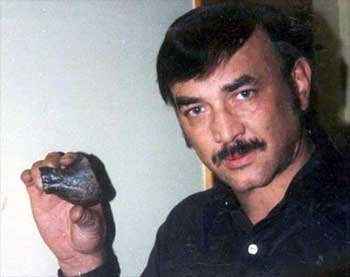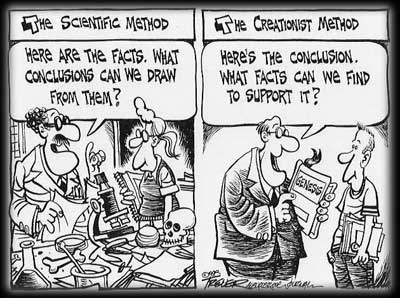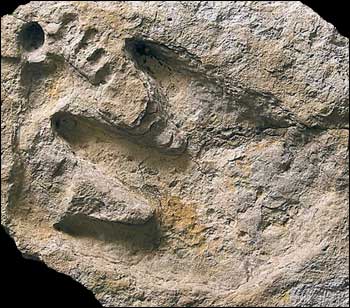“Did you pass through an extended ‘old-earth’ Progressive Creationism stage? If so, what OEC/PC books did you read during that stage, and what were your main problems with them?”

“I went from young-earth to old-earth, and accepting common ancestry.” I did change from young to old-earth, and also went from special creation to accepting evidence for common ancestry.
Glenn Morton was someone I knew who had struggled greatly over the age of the earth question for over a decade, along with ways to still interpret Gen. 1 in a scientific fashion. Glenn mentions in his testimony that his faith in the Bible was saved when he ran across the “Proclamation Day” concordancy explanation in a book by old-earth creationist Alan Hayward, Creation and Evolution. Even today Glenn continues to argue for a concordancy between the Bible and history, as in the link he clams exists between the flood story mentioned in Genesis and the flood that geologists say catastrophically filled the Mediterranean basin. In fact his views in Foundation, Fall, And Flood “are much different from anything published by either theistic evolutionists or progressive creationists. The most important thing about my current views is what they offer to the young earth creationist. They can accept the entirety of modern science and still have what they want : an historical Bible.” [from Glennʼs “bio” sent to me via e-mail 10/1995]
Glenn Morton claims he is neither a theistic evolutionist, nor a progressive creationist, but remains a believer in a concordancy between the Bible and history.
“how long was it (i.e., a day? a week? a month? a year? that you went through an ‘old-earth stage’, i.e. believed in Old-Earth *Creation.*”
Speaking seriously, my “old-earth stage” (to again use your words) wasnʼt a “stage” at all, neither did it “drag on” (as I already admitted ironically), but it was part of my “intellectual journey.”
I first pondered old-earth creationism and its attendant concordist hypotheses when I was a young-earther, at which time they made little sense, since there seemed little necessity for harmonizations between the Bible and modern geology if the earth was young and the items mentioned on each day were specially created. The Bible spoke of six distinct days, and told us in plain words what was made on each one. In my creationist studies I did run across and read old-earth creationist books by Dan Wonderly (his first book, Godʼs Time Records in Ancient Sediments discussed his harmonization of the Bible and science in the rear). Alan Haywardʼs “Proclamation Day” view is one I learned of later. I already knew about “day-age” and “gap” hypotheses. I also recall having read a book by old-earth creationist Pattle Pun, and I subscribed to the ASA journal (containing articles by Christian old-earth creationists and theistic evolutionists). But my ponderings did not lead me down either the Stephen-sian, nor the Morton-ian roads to concord between Genesis 1 and science. Hereʼs what happened along my intellectual journey, I ran across articles by “creationist-watcher” Robert Schadewald who alluded to “flat earth” verses in the Bible (If you type both Robert Schadewald and flat earth into google youʼll find that several of his articles have found their way onto the web). I focused my studies on the questions Schadewald had raised (I mentioned this part of my intellectual journey in Leaving The Fold in the text and in a lengthy footnote). I focused on the meanings, derivations, context and usage of the Hebrew words for “firmament” and “circle “ along with verses that implied either a flat-earth and/or a geocentric one. I was surprised to learn from Schadewald about a Bible-believing preacher of the truth of the earthʼs flatness who lived in Zion, Illinois during the 1920s, who broadcast daily against the evils of “modern astronomy” from one of the largest radio transmitters in America at that time and who also attended the Scopes Trial! Schadewaldʼs articles even altered me to the existence of modern day geocentric creationist Christians and their arguments from the Bible. You can find their articles on the web if you look under Geocentricty and Dr. Bouw (a modern day Christian creationist geocentrist with a Ph.D. in astronomy from Case-Western).
It dawned on me after quite a lot of research that the Bibleʼs creation account appeared at the very least geocentric, and even closely resembled Babylonian and Egyptian accounts that spoke about the earth being the flat firm foundation of creation, created before the sun, moon and stars, lying beneath a holy heaven that had been raised via a splitting of waters which were held back by a solid dome. More and more of my readings in ancient near eastern creation accounts, word meanings, and iconography led me to that conclusion. (I wrote Does The Bible Teach Scientific Creationism at that time, and sent it off to three scholars of different faiths who were authorities on Genesis. And they each congratulated me on my research and admitted they had learned something from my work.) At that point it seemed to me that a concordist approach would not impress anyone who was familiar with the Bibleʼs connections to ancient cosmologies/cosmogonies. It appeared that “concordists” were too busy matching what they thought modern cosmology/geology/biology “really taught,” with what they thought Genesis (chapter 1) “really taught,” all the while ignoring What Genesis Might Have Meant To Those Who Lived Near The Time Of Its (Assumed Mosaic) Authorship. So concordism came to appear like an ingenious match game to me, stretching a word, a verse, a verb form, and seeking some correspondence with modern science until “matches appeared” seemingly “miraculously” in the eyes of the concordists who found them, yet who took no credit for their ingenuity in coming up with their ever new matches and concordist hypotheses.
For an idea of what Genesis 1 and 2 might have meant to ancient Hebrews living in Mosesʼ day, I suggest Professor Conrad Hyersʼs book, The Meaning Of Creation. Itʼs written for the general public and also for evangelical Christians, since Hyers remains a moderate Christian. I had run across Professor Hyersʼs previous book, The Comic Vision And The Christian Faith, along with several of his other works, and wrote him a letter of admiration after which he wrote back and told me he had begun to write a new book called The Meaning Of Creation, excerpts of which I wound up featuring in my zine “Theistic Evolutionistsʼ Forum.” I even got him a speaking gig during “Preacherʼs Week” at Furman University where I worked. And his testimony later appeared in Leaving The Fold (because Hyers, oddly enough, had been a fundamentalist and had attended a fundamentalist university in his youth, the same university in the town where I live).
That is pretty good going getting “a Bachelor of Science in biology” while also studying “all the Christian apologists I could get my hands on … everything by C.S. Lewis, G.K. Chesterton (about thirty books in all), all of Francis Schaeffer,some Os Guiness, Josh McDowell, and some Reformed Presbyterian writers too”. Either Ed is a genius or “a B.S. in biology” was an easy course in those days. I am studying for “a B.S. in biology” full time now, and I barely have time to read my textbooks and set readings!
Edward: youʼre just jealous. I never had trouble in school or college, studied little, but almost always made the Deanʼs list. I was young, sober, curious. I was also single, living at home, commuting to college. No wife, no kids, and fewer chores and interruptions than most, and as I said a driven curiosity. I began reading Lewis and Schaefferʼs works while a sophomore in high school since they were for sale off a bookrack in the first church I began attending, where I was rebaptized, Jacksonville Chapel in Pequannock, New Jersey. Later I had access to university libraries including the one at Fairleigh Dickinson and before that the Princeton Theological Seminary library that I visited while commuting back and forth to school in Trenton. Though I also bought a lot of books through the mail and in Christian bookstores. In pre-Zondervan days Christian bookstores were more interesting, even more appealing. I got to know the owners, talked and prayed with some of them. Speaking of the Princeton Theological Seminary Library, I had an evangelical friend who went to seminary there and introduced me to the campus including the library where he told me I could use it (he was at first just as on fire for the Lord as I was, we had prayed together when we were both freshmen at our different colleges, but after a few years at Princeton he started to learn things about the Bible and about the variety within Christianity and he became more ecumenical, in fact I could sense that something was different about him, his faith was no longer exactly like mine, by that I mean he didnʼt take as great delight in the same Bible phrases I quoted to him, nor take as much delight in my stories about sharing Jesus to this or that perons and “saving souls” like I still did at college. Now that I think back on it, I would undergo a similar change years later.) I have always been a reader and I loved the way I could find whatever books I was seeking, though at that time they were almost always young-earth books. Iʼve been haunting libraries and bookstores since I was in high school. Still do, and have gone to Bob Jones to read creationist mags every so often. And work in a university library now. About the quantity of books I read between my sophomore year in high school and my senior year in college, I canʼt recall all their names, mostly books I picked up at the Mustard Seed bookstore in Ramsey, N.J. a big Christian bookstore with a first floor and basement filled with evangelical books for sale, and also a Christian rock music listening room featuring records by Larry Norman, Phil Keaggy, Randy Stonehill, Love Song, Honeytree, Michael Omartian. I think Christian music sounded better back then 1974-79 than it does today. I also spent loads of time at the Lamplighter Christian Bookstore in Princeton, a shop with a Narnian theme and lots of books by “Word” publishing. They had a reading room where we prayed. Letʼs see, the authors and titles I recall foremost off the top of my head included, Os Guiness—at that time he had only published a few Intervarsity tracts and his first book, The Dust Of Death. I read Lewisʼs Pilgrimʼs Regress, Problem Of Pain, Miracles, God In The Dock, Reflections, The Four Loves, Surprised By Joy, along with his sci-fi trilogy and the Chronicles. and a few others I canʼt recall, essay collections I believe. I read Francis Shaefferʼs The God Who Is There, Escape From Reason, He Is There And He Is Not Silent, and some others I canʼt recall. I read Chestertonʼs Orthodoxy, The Everlasting Man, St. Thomas, St. Francis and many of his novels, notably The Ball And The Cross (a thinly veiled semi-autobioraphical novel about his intellectual bouts with his good friend and metaphysical sparring partner, George Bernard Shaw), and many of G.K.ʼs essays, including his debate with Robert Blatchford on religion in the British press. In fact I read the author Martin Gardnerʼs book, The Whys Of A Philosphical Scrivener, and wrote him especially since he had a B.S. like me, but became an author (puzzle columnist for Sci Amer. and also columnist for the Skeptical Inquirer) and found out he was also a G.K. fan and lived in a nearby town and he loaned me two rare books by Chesterton, one was G.K.ʼs play, Magic and the other was Manalive. Josh McDowell had only published the first edition of ETDAV. (See my review of chapter 12 of that book on the Secular Web.) And the Reformed Presbyterian writers included Cornelius Van Till (two prolegomenas by him and one tract by him, “Why I Believe in God”), Rushdooney (The One And The Many, The Mythology Of Science), and a Gordon Clarke intro to philosophy, and oh yes, another book published by that same Reformed Publishing House that argued for a literal interpretation of Genesis. I read some of the Reformed Presbyterian writers after my four years of college, during which time I was working at infrequent part time jobs but mostly staying home, watching Pat Robertson (to whom I donated a weekly amount of money, becoming a 700 Club member) and read and went to some job interviews. That was for a year or more, then the family moved down south (from New Jersey) and I had more time on my hands settling into a new state and a new town. In fact, I visited a friend at Nebraska State for over a month and used their library there to do research into the historical background of the Bibleʼs creation verses.
You do not mention any conflict he had with your “young-earther” beliefs while getting his “B.S. in biology". Maybe you will elaborate on that?
Edward: You obviously want to hear the whole unedited version of my story. I evangelized all of my college teachers. I gave away copies of Weston-Smithʼs Manʼs Origin and Manʼs Destiny, and Gishʼs The Fossils Say No! I introduced a film on creationism (a poor film, Iʼm sorry to say, that was also poorly attended) that was shown on my college campus. I obtained copies of slides of Gishʼs presentations from ICR and used them to make a presentation of my own to Ph.D. chemists at a major pharmaceutical company, Hoffmann-La Roche, that I worked for during the summers between semesters. I handed out Gishʼs tracts in the parking lot at my school. I did two colloquium presentations in which I lectured fellow science students on young-earth ideas indirectly—what I did was review the evidence for evolution, like human evolution, and stressed problems in interpretation, and would suggest in the end that maybe there is no fossil evidence at all for human evolution. My Sociology professor allowed me to speak to the whole class telling them about my belief in a super-personal reality (taken from Lewis). I held a free Christian book and tract table three times on campus at Fairleigh Dickenson in which I gave away many evangelical books and tracts. My professor of comparative anatomy and physiology, and comparative embryology, Emile Zebenyi, taught his courses from the perspective of evolution, always mentioning the way this or that cell layer in the embryo or organ in one kind of creature got used in a slightly different but similar way in the next kind of creature. But I questioned him. He was a kind and knowledgeable person, but unable to sway me from young-earth creationism. He didnʼt try to sway me, he just wanted me to learn the material and get through his intensive courses. My Sociology professor was also a kind person, and we studied all sorts of ideas and cultures in his course. He got leukemia a year later and I sang him a Christian song at his bedside, and visited him once more before he died. He was moved by my visits but didnʼt make a profession of faith. Still, we got along well and were close, as close as I also was with my philosophy professor who wrote me into one of his essay questions, involving a crowded boat that would sink with all aboard unless somebody was chosen to leave it and drown. My character, whom he named, “Ed,” was an “evangelical Christian. When faced with the “boat dilemma” I told him and the class that it wasnʼt a dilemma at all, since I would simply volunteer to leave the boat, knowing that death held no fear for me, and so that the others might be spared longer lives in which to find Christ. I even spoke to my Calculus teacher about becoming a Christian. His response was, “You pays your money you takes your choice.” But of course the people I was closest too were fellow Christians, whom I saw daily and met weekly, and stayed over each otherʼs houses, and prayed, and evangelized other people on campus together. It wasnʼt a large college that I spent my first two years at, I transferred after that to a college in Rutherford New Jersey, Fairleigh Dickenson, where I met charismatics and sang and prayed with them, along with meeting priests who were leaders in the burgeoning nationwide Catholic Charismatic movement of the late 1970s. By the way, during my first two years of college I was elected president of my campus group, the most evangelical on campus. It was called, Chi Alpha, “Christʼs Ambassadors.”
Have you ever work as a biologist? I notice that you are a “Serials Acquisitions Assistant” in the library of Furman University, South Carolina
I never claimed I worked as a biologist. I worked summers as a lab assistant at a newly built advanced molecular biology lab at Hoffman-La Roche and was offered a full time job there during my third semester in biology at Fairleigh Dickinson, but I declined (dohh) to finish my biology degree in a more timely fashion. Iʼve followed the evolution of the creation debate since the mid 1970s in ICR Impact articles, CRSQ, ASA articles. When Creation/Evolution newsletter and Creation/Evolution Journal appeared (replies to creationist arguments) I began reading that too, as well as its later incarnation, NSCE Reports. And just as you were a member of the Calvin Reflector, I later became a member of a list of Christian theistic evolutionists and atheistic evolutionists who all specialized in studying and discussing creationist arguments, and later, I.D. arguments. I have exchanged letters and emails with participants of this debate over the years, from Henry Morris and Duane Gish (I knew one of his secretaries fairly well, we would even exchange Christmas cards since I had her copying articles from Gishʼs files for me and sending them to me), along with Mark Hartwig (one of the original editors of Origins Research—founded with seed money from ICR—which later became Origins and Design), Paul Nelson (of Origins and Design), Kurt Wise, Glenn Morton, Robert Schadewald, Conrad Hyers. A few other writers, all Christian, whom I have exchanged personal correspondence with over the years include Gary Habermas, Paul Seeley, Dan Wonderly, Alan Hawyard, and Robert Farrar Capon. Phil Johnson even sent me one or two brief responses over the years.
In my job I see the latest science magazines as they arrive. And I can order as many interlibrary loans as I want. To someone like me itʼs a genuine gas. And two years ago I moved across the street from the biggest satellite branch of the countyʼs main library, and last week I borrowed ten of the latest books on evolution and some on religion. I also have professor friends in the science departments on the campus where I work. The biology prof is someone I know and I have seen him debate creationists in an event that was held here on campus about five years ago. An I.D.er also came to speak here on campus and I went to see that, and stood up and asked questions afterwards. Though he wasnʼt a big name I.D.er, he was I think local. His name escapes me though he had a book table and was selling books by leading I.D.ers. Some of the Christian groups on campus brought him to campus to speak. Iʼve also debated Kent Hovind, the young-earth creation evangelist, in a church in Georgia. That was about five years ago. I still have loads of slides that I made to facilitate my points during the debate. (Iʼve come quite a ways from using Gishʼs slides to present young-earth creationism to Hoffman-La Roche Ph.D. chemists.)
Johnson says on one of his tapes regarding his conversion from atheism/ agnosticism to Christianity that it is the decision to seriously consider a view that is the real turning point. While the person may not realise it, embracing that view is after that just a matter of time.
Ironic isnʼt it that according to Johnson himself, if you begin taking me and my testimony and arguments “seriously” you too may be at a “turning point,” and “itʼs just a matter of time.” But donʼt worry too much about it, because we both have “seriously considered” many views in our lifetimes, but neither of us has embraced them all did we? By the way, both G.K. Chesteron and Robert Ingersoll agreed that seriousness was not necessarily always a virtue. Chesteron used to say that Satan fell by force of gravity, he took himself too gravely. And he added that a good religion was one that could laugh at itself. Ingersoll used to say that preachers of all religions/philosophies want you to remain serious because thatʼs the first step to accepting wild stories and rumors as fact. Thereʼs one fellow on the web however, who is a religious icon of sorts who does not take himself or his beliefs seriously, his name is Swami Beyondananda. Check him out via google, heʼs pretty funny. By the way, simply by putting more than one word, like a name, in quotation marks in the google search box, will get you to all matches containing that exact name. Mine of course is “Edward T. Babinski.” But you seem to have found out all about me with ease. So I guess you donʼt need further hints.
So your decision to begin and then continue “corresponding with two former evangelical friends, both of whom had left the fold in college” tells me that you had (whether you realised it or not) already made up your mind against Christianity and was just, as you put it, “think[ing] my way out”.
What have you demonstrated? Only that you “(whether you realize it or not) have already made up your mind” concerning my intellectual journey. (Thatʼs O.K. though because Iʼve made up mind about yours too. * smile *) So letʼs skip the cheap psycholoanalyzing. My friends might still have some of the hundred or so lengthy letters I sent them during the five years we corresponded. I know what I wrote, and I was not trying to convince myself to leave the fold. It was agony for me to see them risking hell, to doubt the holy word of God. I cited Lewis, Chesterton, McDowell, and others, using arguments very similar to those in a book I ran across recently, Letters To A Skeptic or a similar title that I saw at Barnes and Noble. I found the book interesting because thatʼs exactly what I sounded like when I wrote my friends years ago. My letters were like that authorʼs, utilizing the “Liar, Lunatic or Lord,” argument and other concerning the Bibleʼs trustworthiness, the meaning of dogmas, Christian history, psychology, etc. I also loved studying my faith and knowing why I believed and sharing it with my friends, I daresay I believed more fully in my faith after the first few years of my letter debates/conversations with them, I even felt inspired writing those letters, in a Lewisian way, in a Sheldon Vaunaken-ian way (Sheldon was a student of Lewis who wrote an inspiring autobiography about his own journey toward Christianity). What changed me in the end was stepping off the path of “acceptable Christian reading” and reading far more widely (widening my roots which were already deep into Christian soil, but I began to spread out side roots into other soils by reading “the opposition?” Iʼm trying to use your analogy) and thinking about my beliefs in ways I formerly had not. Hence, I “thought” my way out rather than those who complain that the church or the pastor wronged them or showed too much hypocrisy. I liked Christian worship and Christian friends. I still have Christian friends, like Artie Silver, from that time period. The worst thing I could say about churchgoing in the end was that it was getting boring, repetitive, and I didnʼt think that rhetoric and raising oneʼs voice was superior to quiet study and thinking. My thinking during the ending years of my letter debates with these highly intelligent friends of mine was accompanied by anguish, the pain of change. I think that people basically remain the same until the pain of remaining the same is greater than the pain of changing. And it grew more painful for me to assume I knew all the answers after a while, than to admit I no longer was as sure of them as I once was. If I didnʼt have long time correspondents, perhaps I might not have ever changed. Itʼs possible that simply their ability to read and listen to me and treat me kindly had something to do with my dawning realization that they were like me in more ways than either of us were different. In the end I suppose that the division between the “damned and the saved” grew less clear in my mind, my appreciation of persons as individuals was growing instead of viewing each individual as a theological abstraction that one could place in neat tidy categories based on their answer to the question, “Do you accept Jesus Christ as your personal Lord and Savior?”












